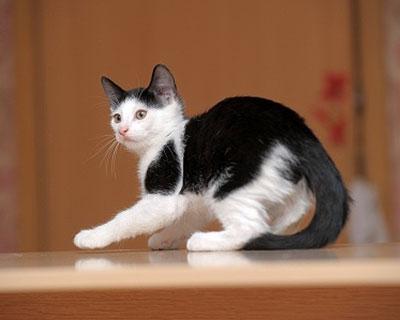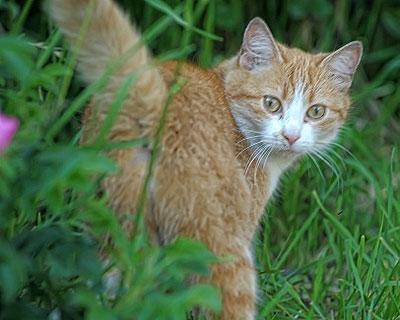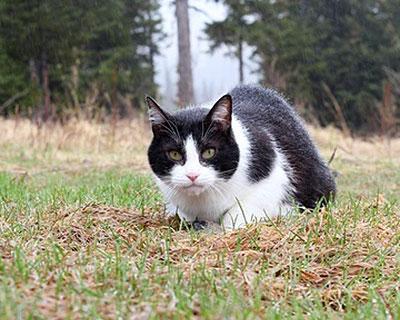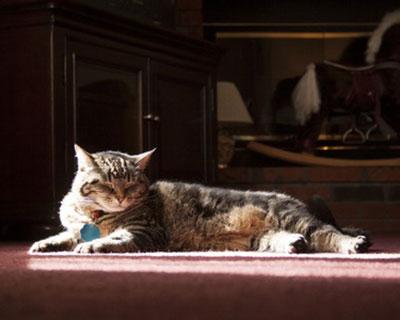This content is archived from the Feline Nutrition Foundation
Eight Cat Curiosities
- Updated: Monday, May 20, 2019 03:55 PM
- Published: Saturday, February 21, 2015 05:37 PM
- Written by Margaret Gates
 I've had cats my whole life. Except for a brief period in my younger days in a no-pets apartment, they have always been there. There are pictures of me as a baby snuggled up to a kitty bigger than I was. As a child, my father insisted they go outside at night – sigh – it was a different era. But, I kept the window open in my room to let them back in.
I've had cats my whole life. Except for a brief period in my younger days in a no-pets apartment, they have always been there. There are pictures of me as a baby snuggled up to a kitty bigger than I was. As a child, my father insisted they go outside at night – sigh – it was a different era. But, I kept the window open in my room to let them back in.
One of the most heartbreaking experiences I ever had as a child was leaving a house we stayed in for the summer without one of our cats. Tigger, at the time less than a year old and not neutered yet, ran away or got lost in the woods days before we had to leave. We searched valiantly, but could not find him. We hoped a nearby farmer had taken him in, but we never knew what became of him. In the following summers though, we did see feral cats around the area that looked suspiciously similar to him. We had not seen strays around before, so we hoped this was a sign that he'd survived and even found some lady friends.
You'd think having spent my life around cats, nothing about them would surprise me. Because of my familiarity with them, there are things I simply never noticed. Once I did, it was hard to believe I never had before.
 1. Cats' jaws only move up and down. They can't do the side-to-side movement that we can. This is obvious if you watch a cat eat, which I have done many, many times. It was only when this fact was pointed out to me that I really got it. They eat completely differently than we do. Chewing for them means using their side teeth to cut food into smaller pieces. There is no grinding. They swallow their food whole.
1. Cats' jaws only move up and down. They can't do the side-to-side movement that we can. This is obvious if you watch a cat eat, which I have done many, many times. It was only when this fact was pointed out to me that I really got it. They eat completely differently than we do. Chewing for them means using their side teeth to cut food into smaller pieces. There is no grinding. They swallow their food whole.
 2. Cats stampede. Completely disproving the idea they are aloof, solitary creatures. In this respect, they are herd animals. The more you have, the more impressive this phenomenon. And by impressive I mean destructive. I'm amazed how fast ten cats can clear a room after one gets spooked and panics. Leaving total destruction in their wake. Can you say indoor tornado? Just duck and pick up the pieces afterward.
2. Cats stampede. Completely disproving the idea they are aloof, solitary creatures. In this respect, they are herd animals. The more you have, the more impressive this phenomenon. And by impressive I mean destructive. I'm amazed how fast ten cats can clear a room after one gets spooked and panics. Leaving total destruction in their wake. Can you say indoor tornado? Just duck and pick up the pieces afterward.
 3. Cats don't sharpen their claws. This is completely the wrong word. I was a teenager before I realized all that scratching was to pull off a claw layer to reveal a fresh, sharp claw underneath. As a child, I took the words literally. I thought the scratching was to file the claw to a point in the same way you'd sharpen a pencil. We need to come up with a new word for this. Let's stop confusing literal-minded children. Please.
3. Cats don't sharpen their claws. This is completely the wrong word. I was a teenager before I realized all that scratching was to pull off a claw layer to reveal a fresh, sharp claw underneath. As a child, I took the words literally. I thought the scratching was to file the claw to a point in the same way you'd sharpen a pencil. We need to come up with a new word for this. Let's stop confusing literal-minded children. Please.
 4. It's only people that hate the smell of pee. Cats, and a lot of the rest of the animal kingdom, seem to go out of their way to smell pee. They don't seem bothered by it at all. Humans are disgusted by the smell, but cats are anywhere from indifferent to preoccupied with it. We think they're wrong. Are we the ones missing something here? I know they can register disgust, I've seen that reaction. But pee, nope, never rates disgust from a cat.
4. It's only people that hate the smell of pee. Cats, and a lot of the rest of the animal kingdom, seem to go out of their way to smell pee. They don't seem bothered by it at all. Humans are disgusted by the smell, but cats are anywhere from indifferent to preoccupied with it. We think they're wrong. Are we the ones missing something here? I know they can register disgust, I've seen that reaction. But pee, nope, never rates disgust from a cat.
 5. Cats are mind-bogglingly patient. For all of you who have cats that wake you up demanding food, this may sound all wrong. They may seem incredibly impatient to you. But, you're looking at their interactions with you. It appears they've discovered our short attention spans and adapted their conduct accordingly. Some of their other behaviors exhibit extraordinary amounts of patience. I've seen a cat sit watching a mole hole in the lawn for four hours straight. Eyes never leaving it. Only stretching every hour or so, eyes still locked on the hole. Oh, did I mention it was raining, too? My own have stared at a blank wall for three hours, barely moving. Note: That's the surefire way to tell you have mice that have gotten into the walls of your home.
5. Cats are mind-bogglingly patient. For all of you who have cats that wake you up demanding food, this may sound all wrong. They may seem incredibly impatient to you. But, you're looking at their interactions with you. It appears they've discovered our short attention spans and adapted their conduct accordingly. Some of their other behaviors exhibit extraordinary amounts of patience. I've seen a cat sit watching a mole hole in the lawn for four hours straight. Eyes never leaving it. Only stretching every hour or so, eyes still locked on the hole. Oh, did I mention it was raining, too? My own have stared at a blank wall for three hours, barely moving. Note: That's the surefire way to tell you have mice that have gotten into the walls of your home.
 6. Cat vision isn't the same as ours. Cats have trouble seeing things close up. Have you ever given your cat a treat, placed it right in front of her and watched as she seemed not to notice it? Well, she probably can't see it. She's not being dumb. They can't see the close-up world the way we do. Now, wiggle something in front of a cat, and you'll get her undivided attention. They are attuned to movement and hard-wired to respond to it.
6. Cat vision isn't the same as ours. Cats have trouble seeing things close up. Have you ever given your cat a treat, placed it right in front of her and watched as she seemed not to notice it? Well, she probably can't see it. She's not being dumb. They can't see the close-up world the way we do. Now, wiggle something in front of a cat, and you'll get her undivided attention. They are attuned to movement and hard-wired to respond to it.
 7. There are lots of black cats. This one's a bit odd. Melanism, a genetic mutation that turns an animal's coat black, occurs in many animals. But, it's rare. We all remark on that black squirrel we saw or the black deer, but black cats are everywhere. There's speculation that black coats were reinforced in cats, including some big species, thousands of years ago because the mutation provided some immunity to a virus. It turns out black cats may be the luckiest of them all.
7. There are lots of black cats. This one's a bit odd. Melanism, a genetic mutation that turns an animal's coat black, occurs in many animals. But, it's rare. We all remark on that black squirrel we saw or the black deer, but black cats are everywhere. There's speculation that black coats were reinforced in cats, including some big species, thousands of years ago because the mutation provided some immunity to a virus. It turns out black cats may be the luckiest of them all.
 8. It's frickin' freezing in here Mr. Bigglesworth. Dr Evil was right. A National Research Council study shows a cat's thermoneutral zone is between 86 and 97 degrees Fahrenheit.¹ That's the temperature range in which they don't have to generate extra heat to keep warm or expend energy to cool off. So, what we view as a comfortable room temperature is about 20 degrees too cool for cats. It's no wonder they like to crawl under the covers, snuggle in boxes or bask in the sun. I think I need more kitty heating pads.
8. It's frickin' freezing in here Mr. Bigglesworth. Dr Evil was right. A National Research Council study shows a cat's thermoneutral zone is between 86 and 97 degrees Fahrenheit.¹ That's the temperature range in which they don't have to generate extra heat to keep warm or expend energy to cool off. So, what we view as a comfortable room temperature is about 20 degrees too cool for cats. It's no wonder they like to crawl under the covers, snuggle in boxes or bask in the sun. I think I need more kitty heating pads.
Margaret Gates is the founder of the Feline Nutrition Foundation.
1. National Research Council, Nutrient Requirements of Dogs and Cats, National Academy Press, 2006, 28-48.




